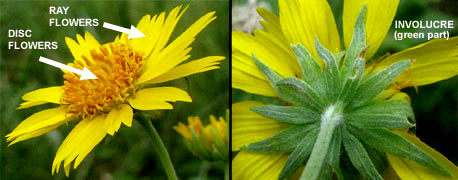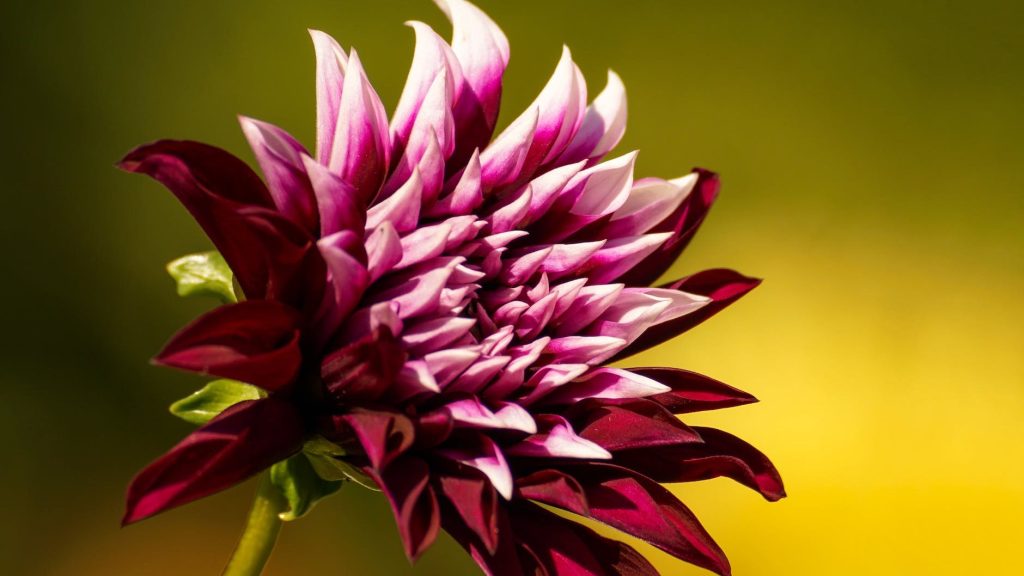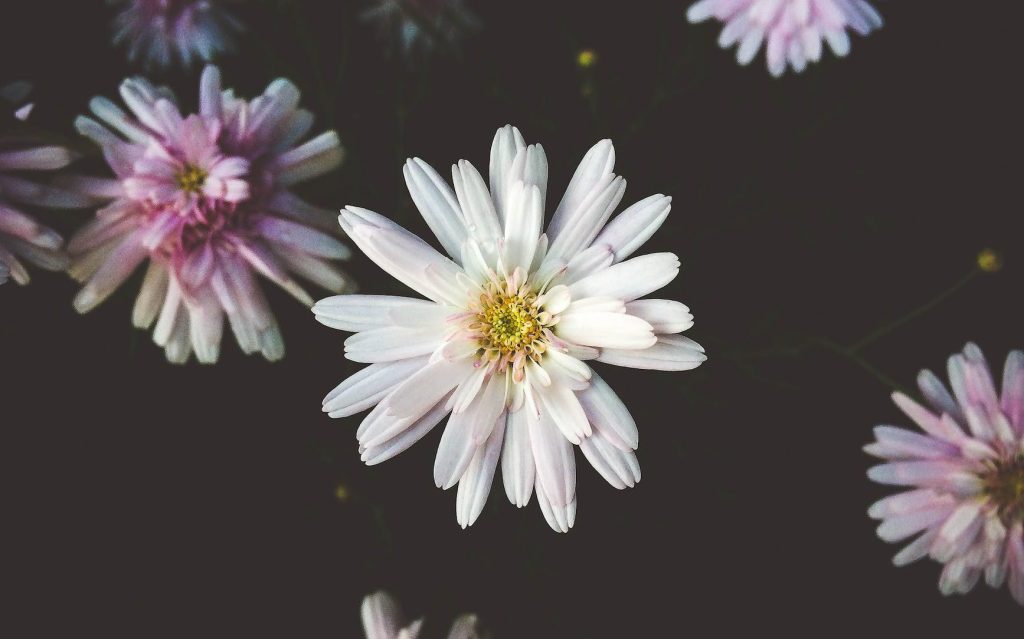We have entered the micro-season of “The Chrysanthemum Flowers”. This is the second micro-season of the mini-season of Cold Dew. The micro-seasons within Cold Dew are:
- The Geese Arrive (Oct 08 – Oct 12)
- The Chrysanthemum Flowers (Oct 13 – Oct 17)
- The Grasshopper Sings (Oct 18 – Oct 22)
These seasons were established in 1685 by Japanese astronomer Shibuka Shunkai and are specific to Japan. However, just because the calendar focuses on Japan doesn’t mean it isn’t applicable to others. No matter where you live you can use these seasons as a starting point for your personal exploration of the world around you.
As a way to celebrate this season, we will learn about the chrysanthemum flower, explore its cultural significance, and then read haiku by Basho, Issa, and Buson.
The Chrysanthemum Flower
The Chrysanthemum, or mum, is a perennial flowering plant part of the Asteraceae family and the genus Chrysanthemum. There are about 40 different species of Chrysanthemums. These plants are primarily native to northeastern Europe, although they are very common in East Asia.(1)
Many species of Chrysanthemum are grown as fall-blooming ornamental plants. They are easy to grow also long as they receive full sun and are planted in good soil with adequate drainage and air circulation.(2) Although the plants enjoy the full sun while growing, the flowers last longer if they are moved to the shadier spots after they bloom. Chrysanthemums usually flower in early September.
The Chrysanthemums flower, which can range in color from white to purple, may contain both disk and ray flowers within the flower heads.(1) Disk flowers are tubular flowers in the center of a composite flower. Ray flowers are the flowers around the margin of the flower head.

Chrysanthemum’s Cultural Significance
China
The Chrysanthemum was first cultivated as a flowering herb in China in the 15th century B.C.(3) Shortly after cultivation, it became a part of the cultural narrative when it joined the Four Gentlemen.(5) The Four Gentlemen, or Four Noble Ones, are the plum blossom, the orchid, bamboo, and the chrysanthemum. These four plants were frequent subjects in traditional Chinese ink and wash paintings. Each one of these gentlemen represents moral character traits promoted in Confucianism. The plum blossom represents inner beauty and humility under adverse conditions, and the orchid represents beauty, grace, and nobility. The bamboo represents values of cultivation and integrity in which one yields but does not break, and the chrysanthemum represents the “virtue to withstand all adversities”(6).
Japan
The Chrysanthemum made its way to Japan in the Nara period (710 – 794 AD) and gained significant popularity during the Edo Period (1603-1867).(4) During this time, Japanese culture was heavily influenced by Chinese culture, and the imperial family was so taken by this flower that it incorporated the chrysanthemum into the emperor’s crest. The emperor himself then became known as the “chrysanthemum throne”.(7)
The chrysanthemum still holds a prominent place in Japanese culture as its likeness is used on currency, clothing, and on their passports. There is even an award called the Supreme Order of the Chrysanthemum, which is the highest honor someone can receive.(7)
Some Fun Facts About Chrysanthemum
- Mums are considered an emblem of youth in Chinese and Japanese culture.
- It’s said that a single petal placed at the bottom of a glass of wine enhances longevity.
- In the language of flowers, a red mum means “I love you” and a white mum means innocence, purity, and pure love.
- In the United States, the chrysanthemum is November’s birth flower. In Japan, the chrysanthemum is the flower for the month of September.
- Japan’s National Chrysanthemum Day (“Kiku no Sekku”) is also called the Festival of Happiness. It is celebrated on September 9th. The holiday was established in 910 AD when the first chrysanthemum show was held.
These fun facts were retrieved from the Farmer’s Almanac and Owlcation.

A Few Seasonal Haiku
The World Kigo Database tells us that the Chrysanthemum or Kiku is an autumn seasonal word. There are many variations on kiku including kiku kuyoo, or the memorial ritual for chrysanthemums.
The memorial ritual for chrysanthemums is held on October 18 at the Asakusa Temple in Tokyo. During this ritual, people present chrysanthemum flowers to the altar of Kannon, the Goddess of Mercy. After the offering has been made, they will take a chrysanthemum that has been left by someone else and bring it home. This flower becomes an “amulet for warding off evil influence in the coming year.”(8)
Now, let’s now read some haiku!
Basho
drinking morning tea the monk becomes peaceful - chrysanthemum flowers (Translation by Gabi Greve)
chrysanthemum fragrance— in the garden, the sole of a worn-out sandal (Translation by Addiss)
Issa
the smell of sake around about dusk... chrysanthemum (Translated by David G Lanoue)
their many colors fade so soon... chrysanthemums (Translated by David G Lanoue)
Buson
lighting the lantern — the yellow chrysanthemums lose their colour (Translated by Robert Hass)
Natsume Sōseki
Before the white chrysanthemum the scissors hesitate a moment. (Translated by Soiku Shigematsu)
A Haiku Invitation
This week’s haiku invitation is to write a haiku or senryu that references the chrysanthemum.
Share your haiku in the comments below, or post on your own page and link back to this post. I can’t wait to read what you write!

Resources:
- “Chrysanthemum”; Brittanica
- “Chrysanthemum: Growin, Care, & Design Tips”; Garden Design
- “Chrysanthemum”; Farmer’s Almanac
- “Chrysanthemum”; Wikipedia
- “The ‘Four Gentlemen’”; Art of the Brush
- “Four Gentlemen”; Chinaonlinemuseum.com
- “How Did the Chrysanthemum Become the Symbol of the Japanese Emperor?”; Owlcation
- “Chrysanthemum (kiku)”; World Kigo Database
Basho’s haiku were retrieved from the World Kigo Database. Issa’s haiku were retrieved from David G. Lanoue’s HaikuGuy.com. Buson’s haiku were retrieved from BreathHaiku. Natsume Sōseki haiku retrieved from Zen Haiku: Poems and Letters of Natsume Sōseki by Sōiku Shigematsu, (New York, Weatherhill, 1994).

Another great post Mark. Thanks for sharing.
Hi Goff, Thanks for the kind words!
In elementary school, the word chrysanthemum knocked me out of the spelling bee championship. You can bet that I’ve known how to spell it ever since.
I love the Buson piece about the yellow flowers losing their colour.
I can understand the spelling bee! I must have spelled chrysanthemum wrong 100 times writing this. Thank goodness for spellcheck! You also have the start to a interesting senryu here. My first draft is:
elementary school
the word is chrysanthemum
I’m out
Hi Mark. here is my response to this week’s prompt ‘Chrysanthemum’.
Happy Friday Everyone.
Thanks for writing and sharing! Another great haiku.
Thank you Mark for the post, the inspiration and the invitation to participate. Have a wonderful day My Friend.
the fragrance
of chrysanthemums
and rosebuds
in my tea…
zen garden
~ Christina Chin
https://take5ive.weebly.com/issue-two-twenty-twenty-two.html
Hi Christina, Thanks for sharing and introducing me to a new journal! Wonderful tanka!
So inspiring story of Chrysanthemum flowers to read ✍️😍Malaysia having these flowers so many varieties and
these dried flowers we will make tea and drink hot seasons 🌷🙏👍🏻 it’s majestic flowers and take bath times
People add in bathtub also 🛁 so many countries it grow as garden flowers 👏👌thank you for sharing 🌷🙏♥️
Hi Thattamma, thanks for adding this information about adding the chrysanthemum to baths, I didn’t know that. Have a great weekend!
Thank you so much for so nice reply message 🌹🙏👍🏼 same wishes for you also 💓👏🏼
memorial stone…
silk chrysanthemums added
to reflect the season
~Nancy Brady, 2022
Hi Nancy, This is great. I enjoy imagery and then the suggested memorial stone caretaker who returns every season to change out the flowers. I have made a complete story in my head about what is happening here!
Hi Mark,
Your story is spot on. I walk by this stone nearly every day. There is a memorial stone caretaker, who changes out the flowers with the various seasons. Right now, there is both chrysanthemums and sunflowers. Who knows what the next season will bring? Maybe the flowers will coincide with the micro-seasons. ~nan
Haiku (above) also posted at http://www.nbsmithblog.wordpress.com
Senryû- A Single Chrysanthemum
One chrysanthemum
That’s all I may mention here,
Not enough sylla….
This one is truly fun! I guess the chrysanthemum is just full of haiku inspiration!
Cute tnkerr.
love the fun facts and haikus Mark but what I really want to know is can you deadhead mums and bring them back?
Mine were rockstars 3 weeks ago. Can I grow them next year?
🌈
Hi Cindy, I did notice you asking that question on another blog. Maybe Goff’s? I think the answer is yes! Here is what I found from Spruce.
https://www.thespruce.com/how-not-to-kill-your-mums-847862
Oh you’re right and so far at the nursery they don’t say much so I thought I picked the 2 horticulturists. Thanks for this.. I’ll go check it out💞
Overall they look temperamental after a look. I think the moral of the story for me is don’t pay too much for them cuz they will die anyways! 😹Thanks a lot
🙌🏽
white chrysanthemums
delightfully shortened but
mum’s the word on that
My attempt at 5/7/5 and happy to have finally made it here, Mark.
Hi Eavonka, Thank you for sharing your haiku and joining the conversation! I’m glad you made it!
Chrysanthemums sing
Maple leaves provide descant
Autumn harmony
Wonderful! A harmony of colors highlighting the seasonal transitions. Thank you so much for sharing.
My first thought at seeing the word “Chrysanthemum” was of the tea and also as a flower head that one can use to decorate a dish as a finishing touch. I like the Haikus some of the other commenters came up with.
Hi Melanie, I have never tried chrysanthemum tea. I may have to search that out. I will agree that the contributors haiku are great. I hope all is well!
re:
Before the white chrysanthemum
the scissors hesitate
a moment.
It’s not by Buson despite others attributing it, but Shiki’s novelist friend:
白菊にしばしたゆたふはさみかな
shiragiku ni shibashi tayutou hasami kana
Natsume Sōseki
Zen Haiku: Poems and Letters of Natsume Sōseki
by Sōiku Shigematsu
(New York, Weatherhill, 1994)
see: https://terebess.hu/zen/mesterek/zen-haiku.pdf
is it scissors
that hesitate for a while
white chrysanthemum
version: Alan Summers
Hi Alan, Thanks for this information. After reading I did a little research and it looks like the initial inaccuracy coming from RH Blythe in Haiku Volume 4. I found this article that also points to Natsume Soseki.
Thanks for adding this clarity.
https://www.graceguts.com/essays/s%C5%8Dseki-not-buson-attributing-the-white-chrysanthemum
Updated post with this new information. Thanks again.
Also it’s R.H. Blyth. Some people confuse his spelling if they submit to the British Haiku Society journal Blithe Spirit.
R. H. Blyth:
https://en.wikipedia.org/wiki/Reginald_Horace_Blyth
It’s tricky about spellings and attributions!
Oh my! I am not doing so well with the accuracy of this one. Much appreciated!
Lovely info on this bright flower and I also enjoyed the haikus, here is my offering:
Wonderful haiku for this week. I agree that this week’s haiku are great. Thanks for linking up. Have a great week!
Beautiful haikus. Great post!
Thank you! With so many great chrysanthemum haikus it can be hard to choose which one to share!
Just because I didn’t know where else to put this;
…pink petals…
I hope all is well – Many are concerned ~Jules
Hi Jules, nice haiku…hope you are all right Mark. .
.
(Praying that you are doing well).